Dead Cells offers a compelling gameplay experience through its fluid combat system, intricate procedural generation, and engaging progression mechanics. Players can explore diverse environments and encounter unique challenges with each run. The synergy between weapons and abilities allows for personalised playstyles, while unlockable skills enhance combat options. Mastering these elements is key to improving performance and enjoying the game’s depth.
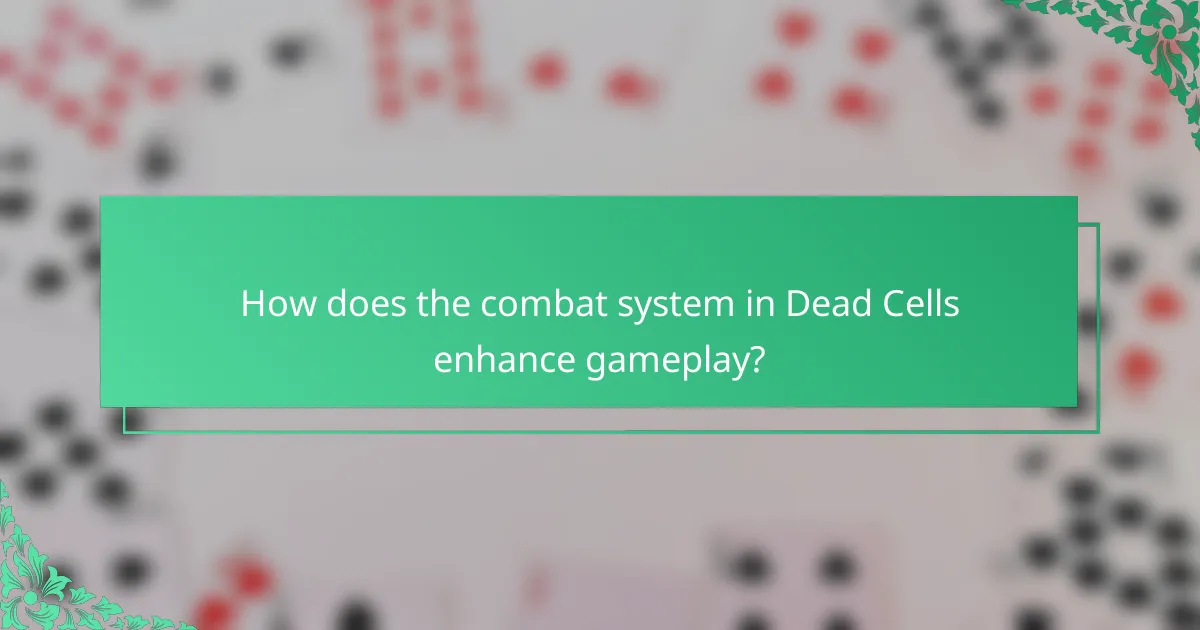
How does the combat system in Dead Cells enhance gameplay?
The combat system in Dead Cells enhances gameplay by providing fluid mechanics, diverse weapon options, and responsive controls. Players experience a dynamic environment where procedural generation ensures varied encounters. Unique attributes like the synergy between weapons and abilities allow for personalised playstyles. The progression mechanics, including unlockable skills and upgrades, encourage exploration and experimentation, deepening player engagement.
What are the core mechanics of combat in Dead Cells?
The core mechanics of combat in Dead Cells include fast-paced action, weapon variety, and strategic positioning. Players utilise melee and ranged weapons, each with unique attributes and attack patterns. The procedural generation of levels ensures diverse encounters, requiring adaptability in combat strategies. Progression mechanics allow players to upgrade abilities and unlock new weapons, enhancing overall combat effectiveness.
How do weapon types influence combat strategies?
Weapon types significantly influence combat strategies in Dead Cells by dictating attack styles, range, and speed. Each weapon category, such as melee or ranged, offers unique advantages and encourages different tactical approaches. For example, melee weapons require close engagement, promoting aggressive play, while ranged weapons allow for distance, facilitating evasive strategies. The choice of weapon impacts not only individual encounters but also overall progression, as players adapt their strategies based on weapon attributes and enemy types. This dynamic interplay enhances the game’s procedural generation, ensuring varied combat experiences with each playthrough.
What role do skills and abilities play in combat effectiveness?
Skills and abilities significantly enhance combat effectiveness in Dead Cells. Mastery of various weapons and abilities allows players to adapt to different combat scenarios. Skills like dodging and timing improve survival, while abilities can deal damage or control crowds. Unique attributes, such as weapon synergy, further amplify effectiveness, enabling players to create powerful combinations. As a result, honing these skills is crucial for progressing through the game’s challenging environments.
How does enemy design affect player tactics?
Enemy design in Dead Cells significantly influences player tactics by introducing varied challenges and requiring adaptive strategies. The diverse enemy types, each with unique attributes and attack patterns, compel players to modify their approach in real-time. For example, some enemies may charge directly, while others employ ranged attacks, prompting different defensive and offensive tactics. The procedural generation of levels ensures that players encounter these enemies in unpredictable combinations, further enhancing the need for strategic adaptability. As a result, mastering enemy patterns becomes essential for progression, reinforcing the game’s core mechanics of skill and learning.

What makes procedural generation a key feature in Dead Cells?
Procedural generation is crucial in Dead Cells as it ensures a unique gameplay experience each run. This feature creates random levels, enemy placements, and item locations, enhancing replayability and challenge. Players encounter diverse environments, which keeps the combat fresh and engaging. The unpredictability of procedural generation also encourages exploration and experimentation with different playstyles, making each session distinct.
How does procedural generation impact level design?
Procedural generation enhances level design by creating unique environments and challenges in Dead Cells. This approach ensures varied gameplay experiences, preventing repetition and maintaining player engagement. Levels adapt to player skills, offering tailored challenges that promote exploration and strategy. The randomness in layout and enemy placement enriches replayability, allowing players to encounter different scenarios in each run.
What are the benefits of a randomized environment for player experience?
A randomized environment enhances player experience by promoting unpredictability and replayability. It keeps gameplay fresh and engaging, as players encounter different challenges and scenarios each time. This variability encourages exploration and experimentation with the combat system, allowing players to adapt their strategies. Furthermore, it fosters a sense of discovery, as players uncover new paths, enemies, and rewards, contributing to a more dynamic progression mechanic. Overall, the procedural generation aspect of Dead Cells significantly enriches the gaming experience.
How does procedural generation influence replayability?
Procedural generation significantly enhances replayability in Dead Cells by creating unique levels and encounters each run. This variability keeps gameplay fresh, encouraging players to explore different strategies and adapt to new challenges. The randomized layouts and enemy placements mean that no two runs are identical, fostering a sense of discovery. Additionally, the integration of various weapons and abilities allows players to experiment with different combat styles, further increasing engagement.
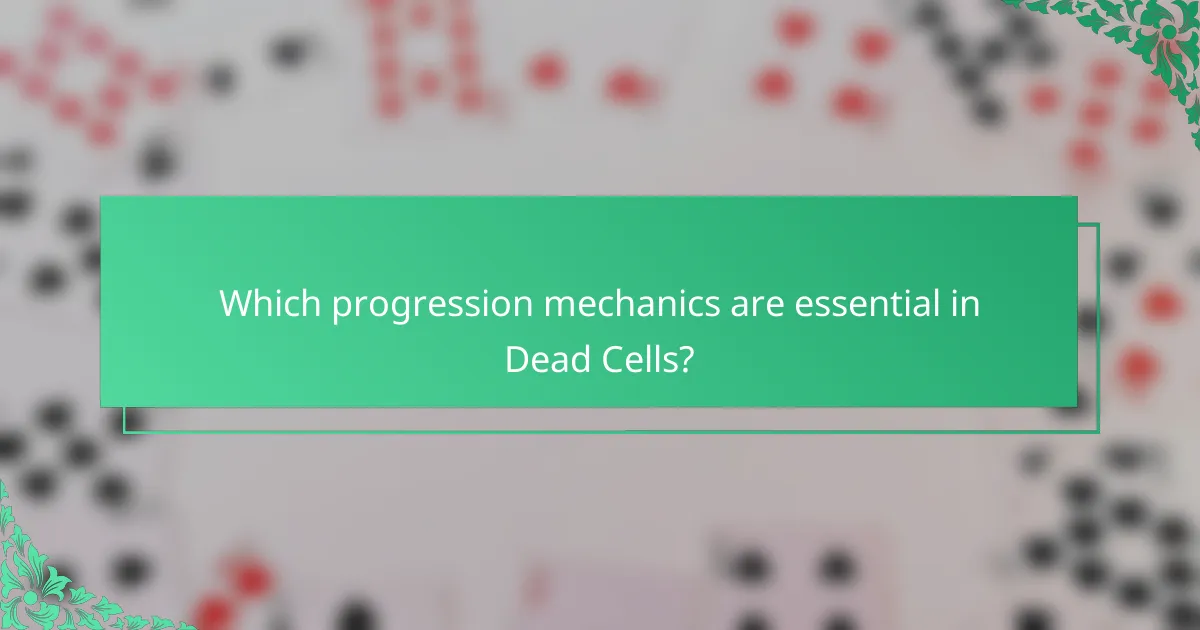
Which progression mechanics are essential in Dead Cells?
Essential progression mechanics in Dead Cells include the Metroidvania-style exploration and a variety of upgrade systems. Players unlock new abilities and weapons through exploration, which enhances combat options. The rogue-lite elements ensure that each run offers unique progression through procedural generation. This combination of exploration and upgrades keeps gameplay fresh and engaging.
How does the upgrade system work for weapons and abilities?
The upgrade system for weapons and abilities in Dead Cells allows players to enhance their combat effectiveness through various means. Players can find blueprints to unlock upgrades, which require specific resources to craft. Upgrades improve attributes like damage, speed, and special effects.
Weapons can be upgraded at the Forge, while abilities are enhanced through the use of cells collected from defeated enemies. Each upgrade significantly impacts gameplay, allowing for diverse combat strategies. Unique attributes of each weapon or ability determine the upgrade paths available, creating a personalised experience for players.
What are the different pathways for character progression?
Dead Cells features multiple pathways for character progression, including upgrading weapons, acquiring new abilities, and enhancing health. Players can choose from various builds that emphasise different playstyles.
Upgrading weapons allows players to enhance damage, while acquiring new abilities introduces unique combat mechanics. Health enhancements increase survivability during challenging encounters.
Additionally, players can unlock permanent upgrades through exploration, enhancing their overall capabilities in future runs. This diverse progression system encourages experimentation and adaptation.
How do collectibles and resources affect advancement?
Collectibles and resources significantly enhance advancement in Dead Cells by providing essential upgrades and abilities. Collectibles like cells and blueprints allow players to unlock new weapons and upgrades, while resources such as gold enable the purchase of items. These elements create a dynamic progression system that rewards exploration and strategic gameplay. The unique attribute of procedural generation ensures that each run offers different collectible placements, fostering replayability and varied strategies for advancement.
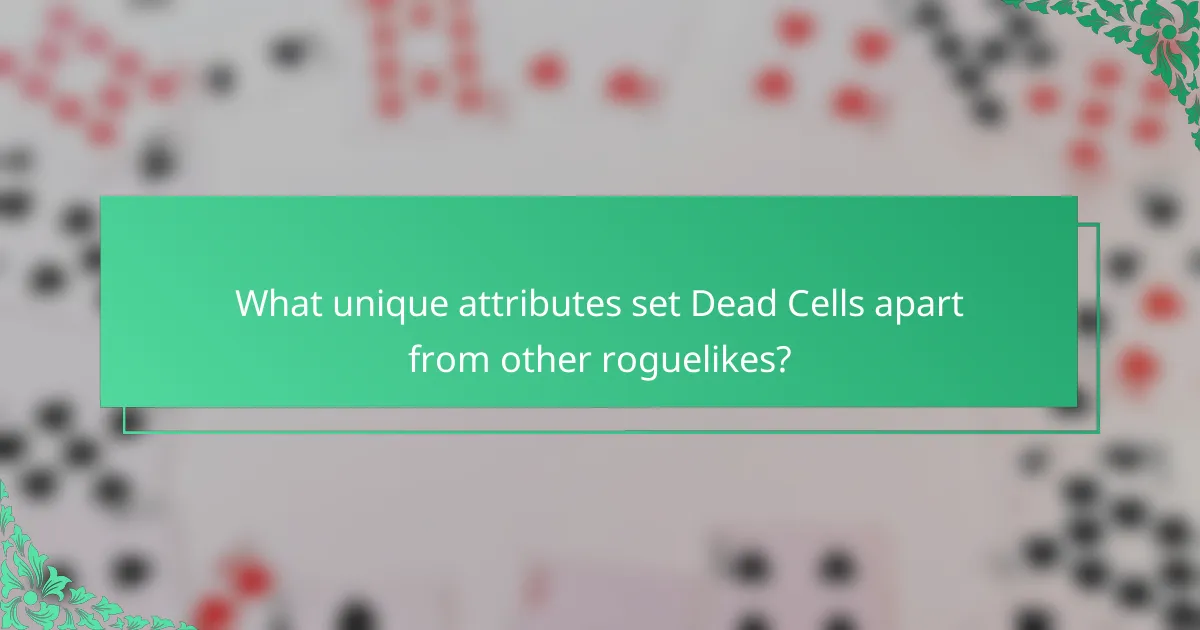
What unique attributes set Dead Cells apart from other roguelikes?
Dead Cells stands out due to its fluid combat system, intricate procedural generation, and unique progression mechanics. The combat system features a blend of melee and ranged attacks, allowing for diverse playstyles. Procedural generation creates varied environments and enemy placements, enhancing replayability. The progression mechanics include permanent upgrades that impact gameplay, differentiating it from typical roguelikes. These elements combine to create a cohesive and engaging experience that keeps players invested.
How does the blend of Metroidvania and roguelike elements create a unique experience?
The blend of Metroidvania and roguelike elements in Dead Cells creates a dynamic and replayable experience. The combat system emphasizes skill and strategy, allowing players to experiment with various weapons and abilities. Procedural generation ensures that each run feels unique, with different layouts and enemy placements. Progression mechanics, such as permanent upgrades and unlockable skills, enhance the sense of achievement while maintaining challenge. This combination results in a game that rewards exploration and adaptability, keeping players engaged through its ever-changing environments and gameplay styles.
What are the distinctive visual and audio design elements in Dead Cells?
Dead Cells features distinctive pixel art graphics and a dynamic soundtrack. The visual design emphasizes vibrant colours and fluid animations, enhancing the game’s fast-paced combat. Audio elements include a mix of orchestral and electronic music, creating an immersive atmosphere. These design choices contribute to the overall experience, making each playthrough unique.
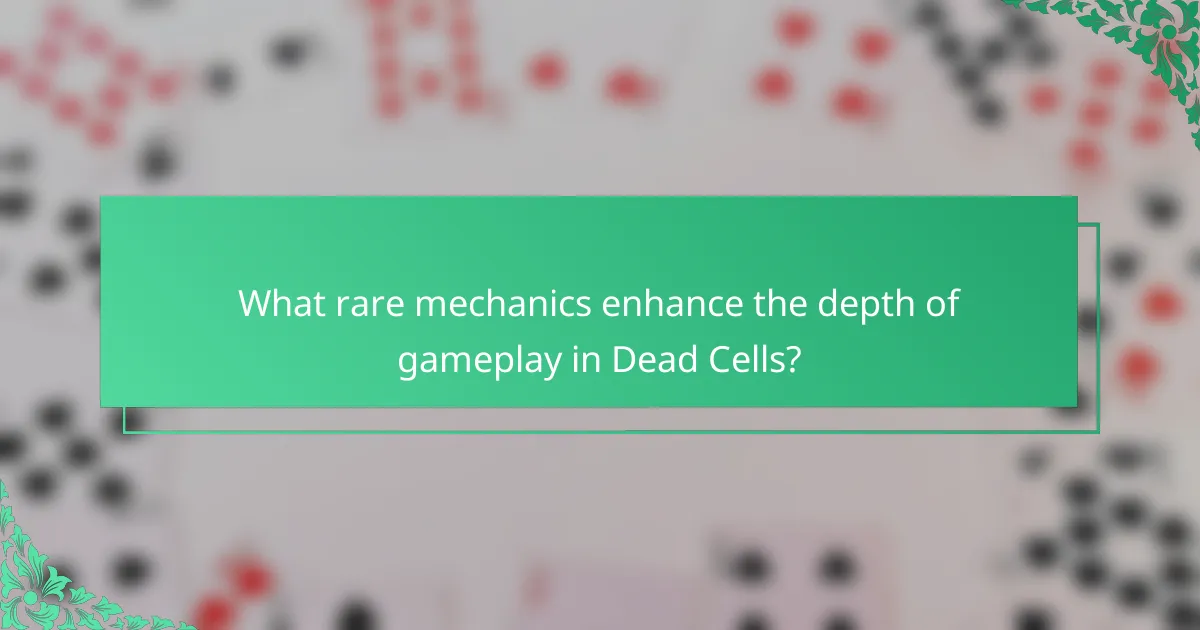
What rare mechanics enhance the depth of gameplay in Dead Cells?
Dead Cells features rare mechanics that significantly enhance gameplay depth, such as the synergy between weapons and mutations. These mechanics encourage diverse playstyles and strategic choices. For instance, the unique attribute of the “Boiling Blood” mutation allows players to deal damage while healing, creating dynamic combat scenarios. Rare combinations of weapons and skills, like the “Scythe” paired with “Ice Shard,” can lead to powerful synergies that alter combat flow. Additionally, the game’s procedural generation ensures that each run offers new challenges and opportunities for exploration, enhancing replayability.
How do boss encounters challenge player skills and strategy?
Boss encounters in Dead Cells significantly challenge player skills and strategy by requiring precise timing, adaptability, and knowledge of enemy patterns. Players must learn to effectively utilise their weapons and abilities while navigating dynamic environments. Each boss presents unique attack patterns and mechanics, demanding players to develop specific strategies tailored to their strengths. Mastery of these encounters enhances overall gameplay and progression, making them pivotal for skill development.
What unique events or encounters can players experience in runs?
Players can encounter unique events like mini-boss fights, special treasure rooms, and unique NPCs during runs in Dead Cells. These events enhance gameplay and offer varied challenges. Mini-boss encounters provide rare loot, while treasure rooms reward exploration with powerful items. Unique NPCs can offer quests or trade valuable resources, enriching the progression experience. Each run can differ significantly based on the procedural generation, ensuring fresh experiences.
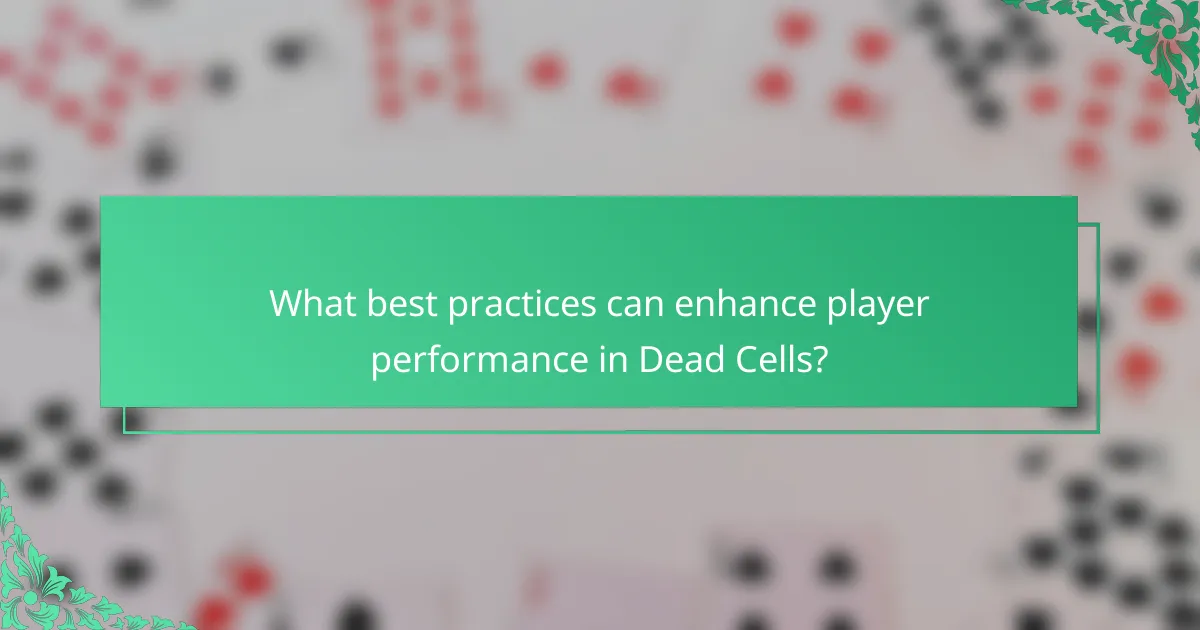
What best practices can enhance player performance in Dead Cells?
To enhance player performance in Dead Cells, focus on mastering combat mechanics, optimising weapon choices, and utilising procedural generation effectively.
First, practice the timing of dodges and attacks to improve survivability. Second, select weapons that match your playstyle, considering attributes like damage output and attack speed. Third, familiarise yourself with the layout of levels, as procedural generation means each run offers unique challenges and opportunities.
Additionally, prioritise upgrades that enhance health and damage, as they significantly impact performance. Lastly, learn enemy patterns to anticipate their moves, allowing for strategic counterattacks.
How can players optimise their builds for different playstyles?
Players can optimise their builds for different playstyles by focusing on weapon synergy, skill selection, and stat allocation. Experimenting with various combinations enhances adaptability.
1. Identify preferred playstyle: Choose between aggressive, defensive, or balanced approaches.
2. Select weapons that complement playstyle: For example, ranged weapons suit a defensive style, while melee weapons enhance aggression.
3. Prioritise skills that enhance chosen weapons: Skills should support the primary damage output or defensive capabilities.
4. Allocate stats based on playstyle needs: Focus on strength for melee, tactics for ranged, or survival for balanced builds.
5. Adapt to procedural generation: Adjust builds according to the layout and enemies encountered in each run.
6. Experiment with unique items: Incorporate rare items that provide specific advantages to refine playstyle effectiveness.
What strategies can help in overcoming challenging areas or bosses?
Utilising effective strategies can significantly aid in overcoming challenging areas or bosses in Dead Cells. Focus on mastering the combat system, leveraging procedural generation, and optimising progression mechanics.
First, familiarise yourself with the unique attributes of each weapon and enemy. Understanding attack patterns allows for better dodging and countering. Additionally, experiment with different builds to find synergies that enhance damage output and survivability.
Second, utilise the environment to your advantage. Many areas contain hazards that can damage enemies, providing opportunities for strategic positioning.
Lastly, prioritise upgrading your gear and unlocking new abilities. Progression mechanics are essential for enhancing your effectiveness against tougher foes. Regularly revisit earlier areas to gather resources and improve your character’s stats.
What common mistakes should players avoid during gameplay?
Players should avoid several common mistakes during gameplay in Dead Cells. Failing to learn enemy patterns can lead to unnecessary deaths. Neglecting to utilise the diverse weapons and abilities limits combat effectiveness. Rushing through areas without exploring can result in missed upgrades and resources. Lastly, ignoring the importance of upgrading gear and abilities can hinder progression significantly.


